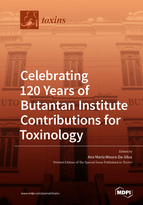Celebrating 120 Years of Butantan Institute Contributions for Toxinology
A special issue of Toxins (ISSN 2072-6651). This special issue belongs to the section "Animal Venoms".
Deadline for manuscript submissions: closed (15 October 2021) | Viewed by 69722
Special Issue Editor
Interests: snake venoms; metalloproteinases; hemostasis; venom composition; venom variability; antivenoms; immunoassays
Special Issues, Collections and Topics in MDPI journals
Special Issue Information
The Butantan Institute was founded by the Brazilian physician and scientist Vital Brazil in 1901, combining, in the same institution, medical research and the transfer of results to society in the form of health products. More than a century after its foundation, Butantan is today an outstanding biomedical research center, which integrates basic research, technological development, production of immunobiologicals, and technical and scientific dissemination, seeking the permanent contribution to Public Health systems. When celebrating Butantan's 120th anniversary, we acknowledge its international relevance and continuous contributions to Toxinology. Butantan houses one of the largest collections of venomous animals in the world, its scientists are involved in countless studies on the characterization of the composition of venoms, mechanisms of action of toxins, and the use of toxins as lead molecules for drug development. The Butantan Institute also operates the "Hospital Vital Brazil", which is specialized in accidents involving venomous animals and is one of the most renowned antivenom producers. This Special Issue of Toxins celebrates the 120th anniversary of the Butantan Institute in recognition of its contribution to global Toxinology and control of neglected tropical diseases. To attend to these goals, we aim to include in this Special Issue recent and advanced contributions to the knowledge of plant, microorganisms, and animal venom toxins. The subjects include toxins characterization, evolution, and mechanisms of action, the venomous animals and toxic plants or microorganisms, highlighting human accidents and antivenoms.
Dr. Ana M. Moura-da-Silva
Guest Editor
Manuscript Submission Information
Manuscripts should be submitted online at www.mdpi.com by registering and logging in to this website. Once you are registered, click here to go to the submission form. Manuscripts can be submitted until the deadline. All submissions that pass pre-check are peer-reviewed. Accepted papers will be published continuously in the journal (as soon as accepted) and will be listed together on the special issue website. Research articles, review articles as well as short communications are invited. For planned papers, a title and short abstract (about 100 words) can be sent to the Editorial Office for announcement on this website.
Submitted manuscripts should not have been published previously, nor be under consideration for publication elsewhere (except conference proceedings papers). All manuscripts are thoroughly refereed through a double-blind peer-review process. A guide for authors and other relevant information for submission of manuscripts is available on the Instructions for Authors page. Toxins is an international peer-reviewed open access monthly journal published by MDPI.
Please visit the Instructions for Authors page before submitting a manuscript. The Article Processing Charge (APC) for publication in this open access journal is 2700 CHF (Swiss Francs). Submitted papers should be well formatted and use good English. Authors may use MDPI's English editing service prior to publication or during author revisions.
Keywords
- Venom composition and evolution
- Plant and microbial toxins
- Mechanism of action of venom toxins
- Human accidents
- Antivenoms
- Venomous animals
- Toxins and drug development







